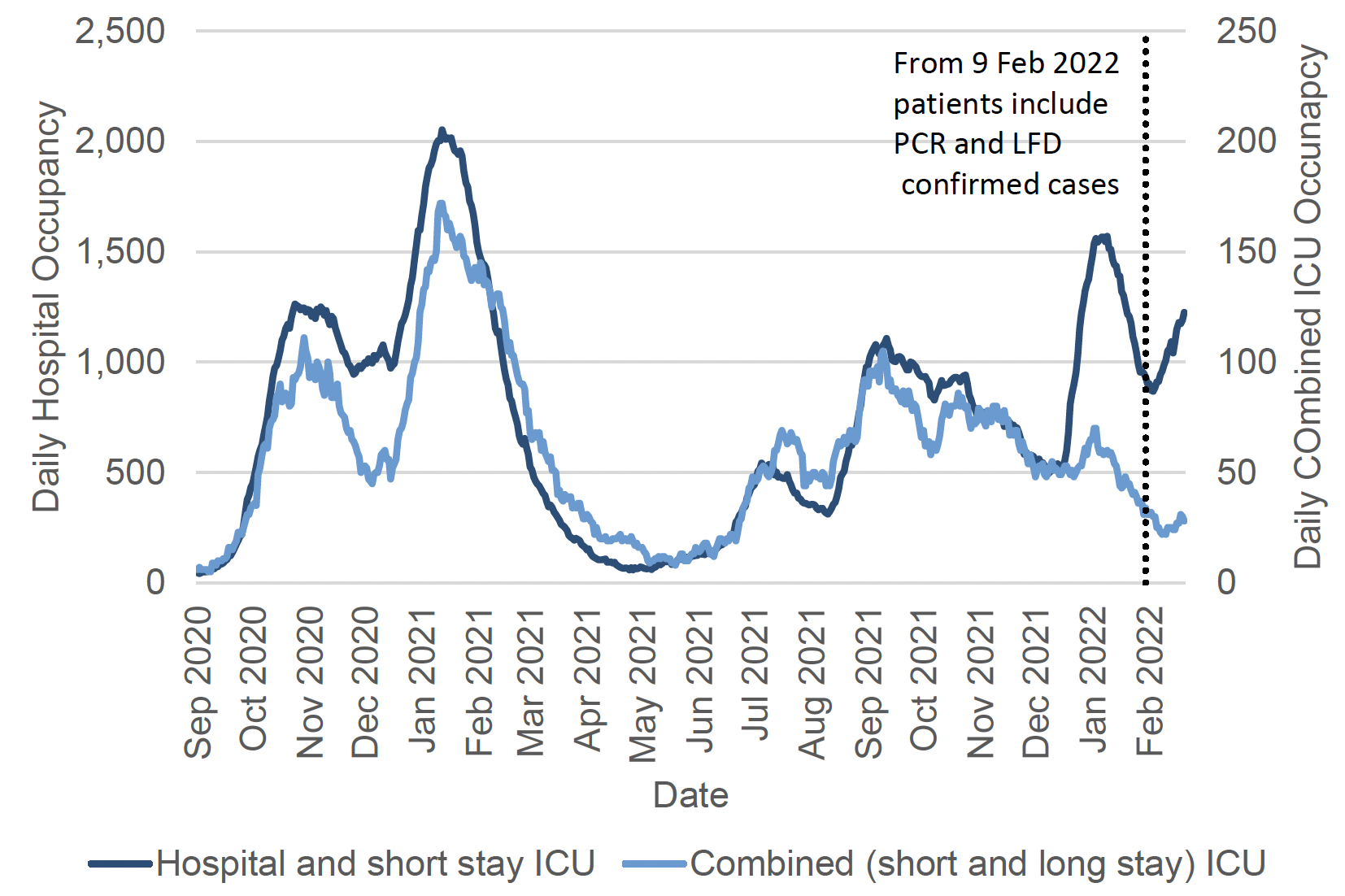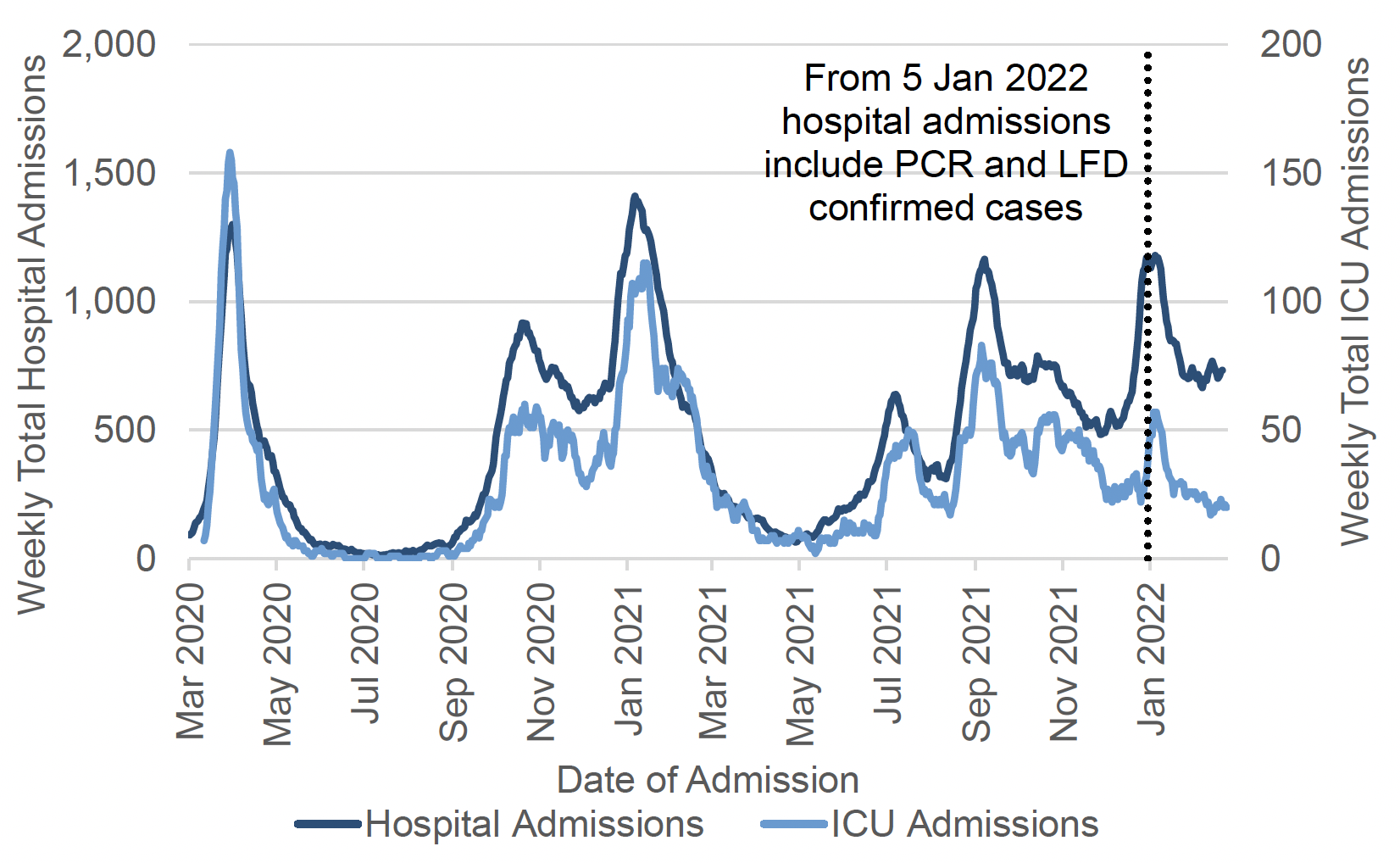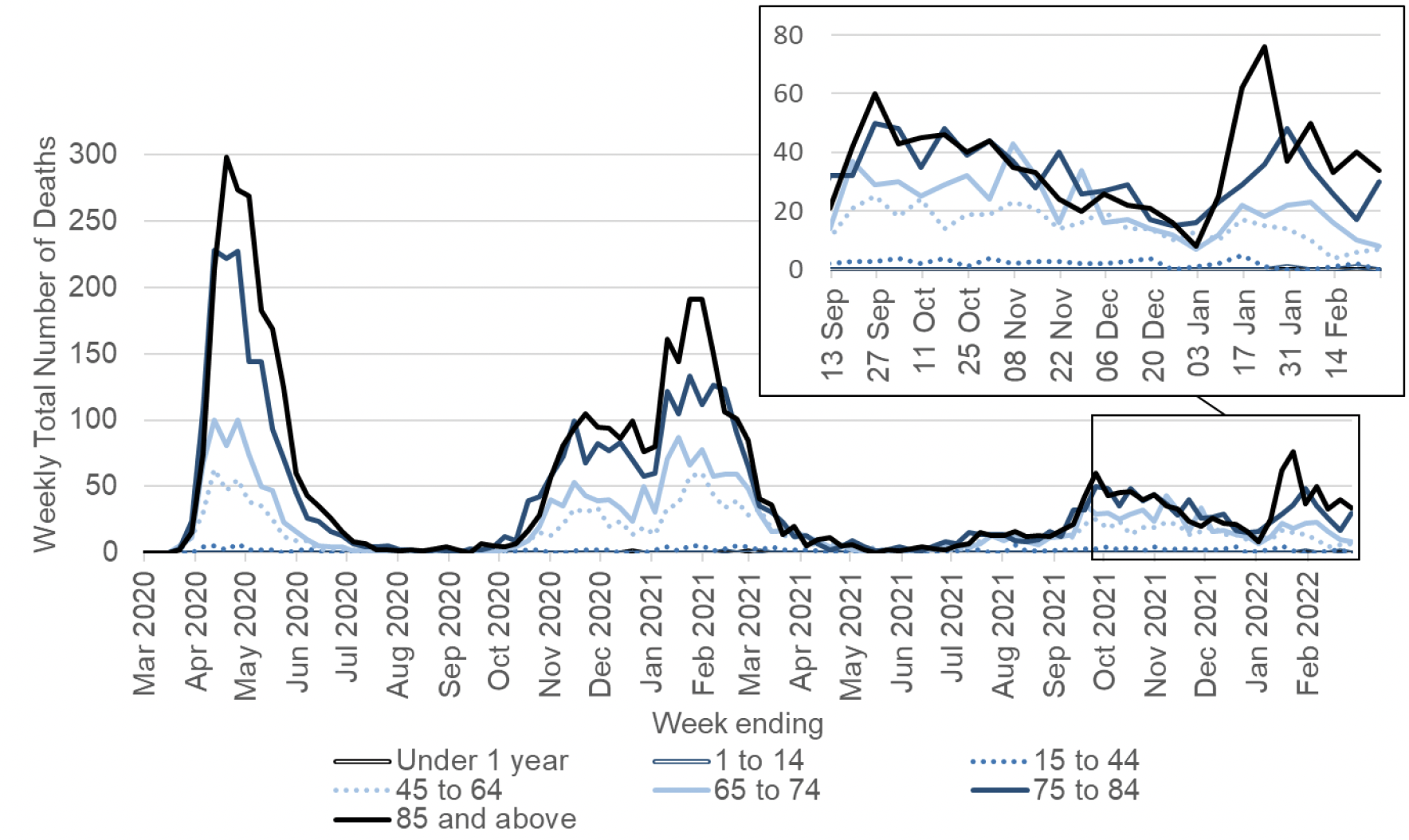Coronavirus (COVID-19): state of the epidemic - 4 March 2022
This report brings together the different sources of evidence and data about the Covid epidemic to summarise the current situation, why we are at that place, and what is likely to happen next.
Severe Illness: Hospitalisation, ICU and Deaths
Hospital and ICU Occupancy and Admissions
Following changes in the Covid-19 Case definition and changing testing policies on 5 January 2022, hospital and ICU occupancy figures include patients with Covid-19 cases confirmed by either PCR or LFD from 9 February and onwards.
Similarly, Covid-19 admissions to hospital (including for children and young people) now include patients with Covid-19 cases confirmed either by PCR or LFD. Historical figures have been updated retrospectively from 5 January 2022. Please note that admissions to ICU only include PCR confirmed Covid-19 cases.
In the week to and including 2 March, daily Covid-19 hospital occupancy increased. NHS boards reported 1,226 patients in hospital or in short stay ICU on 2 March with recently confirmed Covid-19, compared to 1,093 on 23 February. This is an increase of 133 patients, or 12%, compared to a week previously, and an increase of 314 patients, or 34%, compared to two weeks previously (16 February). This compares with 2,053 patients in hospital at the peak in January 2021 (Figure 10).
Combined ICU occupancy (including short and long stay) has increased to 28 patients on 2 March, an increase of 3 patients or 12% compared to a week previously on 23 February. The number of combined ICU occupancy remains lower than the peak of 172 ICU patients recorded in January 2021. There were 16 patients in short stay ICU on 2 March, compared to 11 a week previously (23 February). This is an increase of 5 patients. There were 12 patients in long stay ICU on 2 March, compared to 14 on 23 February (Figure 10)[33].

Admissions to hospital have fluctuated over the last month. In the week to 26 February there were 733 admissions to hospital for people with confirmed Covid-19, which is a similar figure to four weeks previously, with 719 hospital admissions in the week to 29 January. This is a slight increase of 2% over four weeks and compares to 1,179 weekly hospital admissions during the most recent peak in the week leading up to 10 January (Figure 11)[36].
The number of admissions to ICU also appears to be fluctuating. The latest data from PHS shows 20 new Covid-19 patients admitted to ICU in the week to 1 March, compared to 24 four weeks previously in the week to 1 February. This compares to 57 weekly ICU admissions during the most recent peak in early January 2022 (Figure 11 )[37].

According to data from Public Health Scotland, the highest number of admissions in the week to 22 February were among those aged 80 and over. In the same week, approximately 57% of the hospital admissions related to patients aged 60 or older. This is an increase from 50% in the week to 1 February[41]. The proportion of patients staying 48 hours or longer was 57% in the week to 15 February, which compares to 48% in the week to 1 February (as reported on 16 February)[42].
According to data from the PHS Education Dashboard, the three-week rolling average number of Covid-19 related hospital admissions for those aged under 22 peaked in the three-week period leading up to 19 January 2022 at an average of 145 admissions, which was higher than previously seen in the pandemic. While remaining at a high level, average hospital admissions related to Covid-19 in children and young adults have decreased by 10% in the three-week period to 23 February (100 average weekly admissions), compared to the previous three-week period to 16 February (112 average weekly admissions). The only age band among children and young people to see an increasing rolling average of hospital admissions in this time period were those aged 12 to 17. These figures refer both to young patients in hospital because of Covid-19 and with Covid-19, and link to both PCR and LFD test results[43].
While it may be helpful to compare hospital occupancy between the UK nations, any comparisons must be made with caution. Definitions are not consistent across the nations and data are not reported daily by each nation. Data from Scotland, Wales and Northern Ireland is updated retrospectively if errors come to light, while data from England is not revised retrospectively, but instead is corrected in the following day's data update. This means Covid-19 death figures are not directly comparable across the four nations. For more information see UK Government website.
The seven-day average hospital occupancy in Scotland per one million people was 207 patients in the week to 1 March 2022. The seven-day average hospital occupancy per 1 million in the same period for other UK nations were as follows[44]:
- England: 151 per one million,
- Northern Ireland: 285 per one million,
- Wales: 182 per one million.
In Scotland, there was a daily average of 19 hospital admissions per one million people in the week leading up to and including 26 February 2022. Seven-day average hospital admissions per one million in the same period for other UK nations were as follows[45]:
- England: 17 per one million,
- Northern Ireland: 19 per one million,
Wales: 6 per one million.
Deaths
After a period of decreasing numbers of Covid-19 deaths throughout the last two months of 2021, the week to 23 January 2022 saw a peak of 146 Covid deaths. This came after three weeks of increasing numbers of deaths, largely consisting of fatalities among those aged 45 or above, as Covid-19 deaths among younger age groups have remained at similar low levels throughout the pandemic.
The overall number of Covid-19 deaths has increased slightly by 4%, or 3 deaths, to a total of 79 deaths in the week leading up to 27 February, compared to 76 in the week leading up to 20 February. This figure is 88% lower than the peak in 2020, when the week ending 27 April saw a total of 663 deaths where Covid-19 was mentioned on the death certificate[46].
When it comes to Covid-19 related deaths by age groups, there was an increase from 17 to 30 deaths among those aged 75 to 84 deaths in the week to 27 February. Age groups younger than 45 continue to experience low levels of Covid-19 related deaths while the number of deaths are fluctuating at higher levels among those aged 45 and older (Figure 12). National Records of Scotland publish a weekly detailed analysis on deaths involving Covid-19 in Scotland in their weekly report[47].

Excess deaths are the total number of deaths registered in a week minus the average number of deaths registered in the same week over the previous five years (excluding 2020). Measuring excess deaths allows us to track seasonal influenza, pandemics and other public health threats. Excess deaths include deaths caused by Covid-19 and those resulting from other causes.
In the week leading up to 27 February, deaths from all causes were 6% below average levels for this time of year. This constitutes the eighth week in a row where deaths were below average[48].
Deaths data from England, Northern Ireland, Scotland and Wales use different methodologies, so they cannot be directly compared. The death figures below are the daily numbers of people who died within 28 days of being identified as a COVID-19 case by a positive test. The definition of a Covid-19 case aligns with the case definition used in each nation. Deaths following a possible reinfection are included from 1 February for England and Northern Ireland, and from 1 March in Scotland. For more information see UK Government website.
There were 2 average daily deaths per one million population in the week leading up to 2 March 2022 in Scotland, by the date the death was reported. In the same time period, average daily deaths for the other UK nations were as follows[49] [50]:
- England: 1 per one million,
- Northern Ireland: 2 per one million,
- Wales: 2 per one million.
Contact
There is a problem
Thanks for your feedback